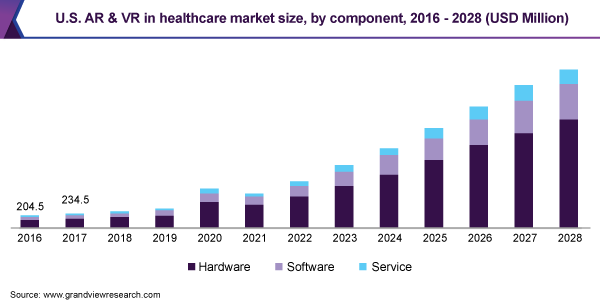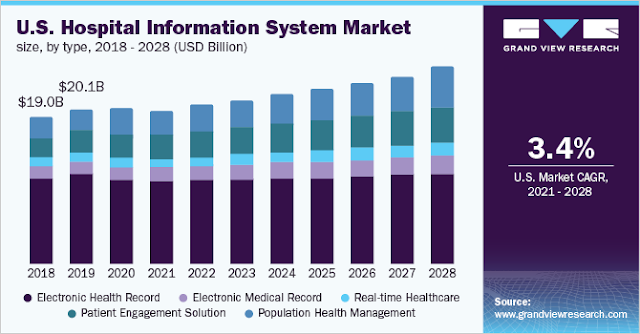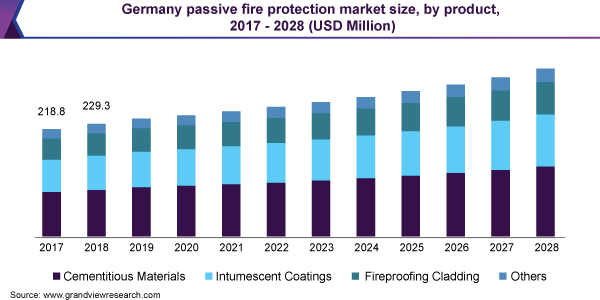Augmented Reality & Virtual Reality In Healthcare Industry Overview
The global Augmented Reality & Virtual Reality in healthcare market size was valued at USD 2.0 billion in 2020 and is expected to expand at a compound annual growth rate (CAGR) of 27.2% from 2021 to 2028.
Technological advancements and digitalization in healthcare, favorable government initiatives, rising healthcare expenditure, growing usage in surgical procedures, and medical training are some of the fundamental factors anticipated to boost the growth and adoption of the augmented reality (AR) and virtual reality (VR) technologies in the healthcare industry. These technologies have wide applications in healthcare including surgeries, diagnostics, rehabilitation, training, and education.
Augmented and virtual reality techniques are being increasingly adopted in surgeries and diagnostics. Systems such as touch surgery use virtual reality to provide a view of the patient’s anatomy and physiology, thereby providing opportunities for surgeons in the operating room, This, in turn, is expected to augment the growth of the market for augmented reality and virtual reality in healthcare. The growing adoption of Augmented Reality (AR) and Virtual Reality (VR) technologies in medical surgeries to optimize surgical procedures and increase the efficiency of treatment is one of the key factors driving market growth over the past few years. For instance, in December 2019, Augmedics launched the Xvision Spine AR guidance system for spine surgeries in the U.S. This solution allows the surgeon to view the 3D spinal anatomy of the patient during the surgery. Augmedics also received the U.S. FDA approval for Xvision in December 2019. Moreover, the increasing practice of storing medical images and patient data on the AR/VR platform helps in reducing requirements for expensive screens and unnecessary staff.
Gather more insights about the market drivers, restrains and growth of the Global Augmented Reality & Virtual Reality In Healthcare Market
Additionally, AR is being widely adopted for education and training purposes for medical personnel. Since AR-based learning modules provide anatomical visualization and simulation it gives the medical personnel a more wholesome complete learning experience. Moreover, these learning modules are even being used to train patients and help them understand the treatment flow and care management better. AR-based image visualization assists the surgeons and enhancing their accuracy and precision during complex surgeries. For instance, in February 2019 Philips Healthcare collaborated with Azurion and Microsoft to develop a mixed reality concept to provide a 3D holographic AR environment derived from multiple image modalities to assist surgeons.
During the outbreak of the COVID-19 pandemic, AR & VR in healthcare was influenced positively owing to the technological advancements in this space. For instance, in April 2020 XRHealth extended its application by raising USD 7 million to expand its telehealth platform. Similarly, Imperial College and St. Mary’s Hospital in London are using augmented reality glasses to visualize 3D imaging of blood vessels during reconstructive surgeries. Augmented reality and virtual reality in healthcare help in efficiently managing the treatment schedules, treatment delivery, and plans, and thereby it is anticipated to exponentially grow during the pandemic. Additionally, the decreasing costs in healthcare, rapid digitalization of healthcare, and improved delivery of effective health services are expected to drive growth. AR and VR in healthcare are gaining momentum due to widespread adoption in telemedicine, medical training & education, patient care management, medical marketing during the COVID-19 pandemic.
Furthermore, mergers and acquisitions, product development and launches, partnerships, and collaborative agreements are some of the crucial initiatives being undertaken by key players, which are expected to propel market growth. For instance, in January 2021 Hologic Inc acquired Biotheranostics, a molecular diagnostics company for USD 230 million. Through this acquisition, Hologic Inc and Biotheranostics will combine their capabilities and utilize their expertise in oncology diagnostics and advanced woman health diagnostics.
Browse through Grand View Research's Healthcare IT Industry Research Reports.
• Oncology Information Systems Market: The global oncology information systems market was valued at USD 2.4 billion in 2021 and is projected to expand at a compound annual growth rate (CAGR) of 7.8% from 2022 to 2030. Monumental growth of healthcare IT, the increasing global prevalence of cancer, increasing expenditure in development around treatment & solutions for cancer care, and increasing adoption of OIS solutions by healthcare facilities is some of the key factors anticipated to drive the growth of the market.
• Real World Evidence Solutions Market: The global real world evidence solutions market size was valued at USD 39.7 billion in 2021 and is expected to expand at a compound annual growth rate (CAGR) of 8.1% from 2022 to 2030. Support from regulatory bodies for using real world evidence (RWE) solutions and an increase in R&D spending are anticipated to boost the market growth.
Augmented Reality & Virtual Reality In Healthcare Market Segmentation
Grand View Research has segmented the global augmented reality & virtual reality in healthcare market on the basis of component, technology, and region:
AR & VR In Healthcare Component Outlook (Revenue, USD Million, 2016 - 2028)
• Hardware
• Software
• Service
AR & VR In Healthcare Technology Outlook (Revenue, USD Million, 2016 - 2028)
• Augmented Reality
• Virtual Reality
AR & VR In Healthcare Regional Outlook (Revenue, USD Million, 2016 - 2028)
• North America
• Europe
• Asia Pacific
• Latin America
• Middle East & Africa
Key Companies profiled:
Some prominent players in the Global Augmented Reality & Virtual Reality In Healthcare Market include
• CAE
• GE Healthcare
• Koninklijke Philips N.V.
• Intuitive Surgical
• Siemens Ltd
• Eon Reality, Inc
• Layar
• Bioflight VR
• WorldViz
• TheraSim Inc
• Mindmaze
Order a free sample PDF of the Augmented Reality & Virtual Reality In Healthcare Market Intelligence Study, published by Grand View Research.





